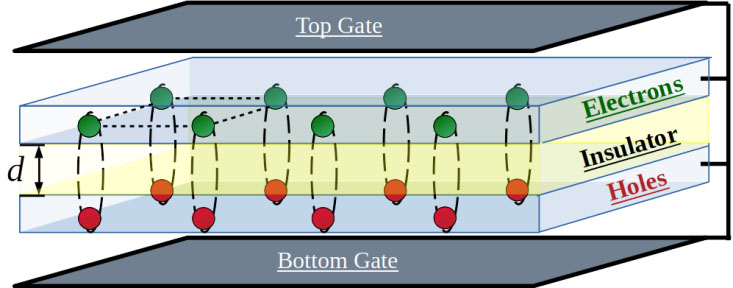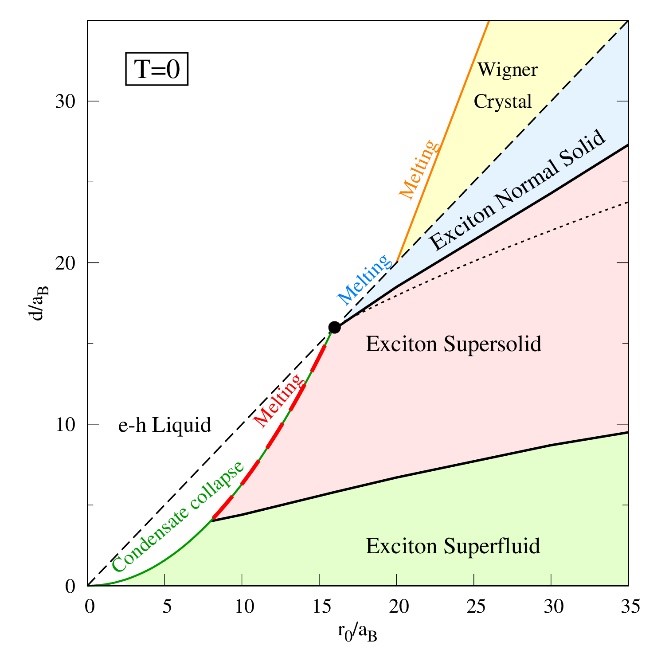| Mar 30, 2023 |
Can a solid be a superfluid? Engineering a novel supersolid state from layered 2D materials
(Nanowerk News) A collaboration of Australian and European physicists predict that layered electronic 2D semiconductors can host a curious quantum phase of matter called the supersolid.
|
|
The supersolid is a very counterintuitive phase indeed. It is made up of particles that simultaneously form a rigid crystal and yet at the same time flow without friction since all the particles belong to the same single quantum state.
|
|
A solid becomes ‘super’ when its quantum properties match the well-known quantum properties of superconductors. A supersolid simultaneously has two orders, solid and super:
|
|
solid because of the spatially repeating pattern of particles,
super because the particles can flow without resistance.
|
|
“Although a supersolid is rigid, it can flow like a liquid without resistance,” explains Lead author Dr Sara Conti (University of Antwerp).
|
|
The study (Physical Review Letters, "Chester Supersolid of Spatially Indirect Excitons in Double-Layer Semiconductor Heterostructures") was conducted at UNSW (Australia), University of Antwerp (Belgium) and University of Camerino (Italy).
|
 |
| A supersolid can be engineered in a structure comprising two conducting layers separated by an insulating barrier. The upper layer is doped with negatively-charged electrons and the lower layer with positively-charged holes. Interlayer excitons (bound pairs of an electron and a hole) form the supersolid. (Image: FLEET)
|
A 50-year journey towards the exotic supersolid
|
|
Geoffrey Chester, a Professor at Cornell University, predicted in 1970 that solid helium-4 under pressure should at low temperatures display:
|
|
Crystalline solid order, with each helium atom at a specific point in a regularly ordered lattice and, at the same time,
Bose-Einstein condensation of the atoms, with every atom in the same single quantum state, so they flow without resistance.
|
|
However in the following five decades the Chester supersolid has not been unambiguously detected.
|
|
Alternative approaches to forming a supersolid-like state have reported supersolid-like phases in cold-atom systems in optical lattices. These are either clusters of condensates or condensates with varying density determined by the trapping geometries. These supersolid-like phases should be distinguished from the original Chester supersolid in which each single particle is localised in its place in the crystal lattice purely by the forces acting between the particles.
|
|
The new Australia-Europe study predicts that such a state could instead be engineered in two-dimensional (2D) electronic materials in a semiconductor structure, fabricated with two conducting layers separated by an insulating barrier of thickness d.
|
|
One layer is doped with negatively-charged electrons and the other with positively-charged holes.
|
|
The particles forming the supersolid are interlayer excitons, bound states of an electron and hole tied together by their strong electrical attraction. The insulating barrier prevents fast self-annihilation of the exciton bound pairs. Voltages applied to top and bottom metal ‘gates’ tune the average separation r0 between excitons.
|
|
The research team predicts that excitons in this structure will form a supersolid over a wide range of layer separations and average separations between the excitons. The electrical repulsion between the excitons can constrain them into a fixed crystalline lattice.
|
 |
| "The phase diagram’s triple point is particularly intriguing. There should be exciting physics coming from the exotic interfaces separating these domains." The system phase diagram maps state against layer separation (da/b) and exciton density (r0, average separation between excitons). (Image: FLEET)
|
|
“A key novelty is that a supersolid phase with Bose-Einstein quantum coherence appears at layer separations much smaller than the separation predicted for the non-super exciton solid that is driven by the same electrical repulsion between excitons,” says co-corresponding author Prof David Neilson (University of Antwerp).
|
|
“In this way, the supersolid pre-empts the non-super exciton solid. At still larger separations, the non-super exciton solid eventually wins, and the quantum coherence collapses.”
|
|
“This is an extremely robust state, readily achievable in experimental setups,” adds co-corresponding author Prof Alex Hamilton (UNSW). “Ironically, the layer separations are relatively large and are easier to fabricate than the extremely small layer separations in such systems that have been the focus of recent experiments aimed at maximising the interlayer exciton binding energies.”
|
|
As for detection, for a superfluid it is well known that this cannot be rotated until it can host a quantum vortex, analogous to a whirlpool. But to form this vortex requires a finite amount of energy, and hence a sufficiently strong rotational force. So up to this point, the measured rotational moment of inertia (the extent to which an object resists rotational acceleration) will remain zero. In the same way, a supersolid can be identified by detecting such an anomaly in its rotational moment of inertia.
|
|
The research team has reported the complete phase diagram of this system at low temperatures.
|
|
“By changing the layer separation relative to the average exciton spacing, the strength of the exciton-exciton interactions can be tuned to stabilise either the superfluid, or the supersolid, or the normal solid,” says Dr Sara Conti.
|
|
“The existence of a triple point is also particularly intriguing. At this point, the boundaries of supersolid and normal-solid melting, and the supersolid to normal-solid transition, all cross. There should be exciting physics coming from the exotic interfaces separating these domains, for example, Josephson tunnelling between supersolid puddles embedded in a normal-background.”
|


